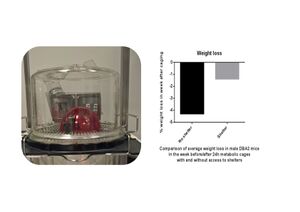Metabolic cages
Metabolic cages create both welfare and scientific challenges and their use should be limited to procedures which are strictly necessary. Kalliokoski et al. (2013) concluded that mice do not habituate to metabolic cages.
Contents
Access to shelter in mouse metabolic cages
Introduction
An elevated level of albumin in the urine is a result of leakage across the kidney barrier and the use of 24h urine collection to calculate albumin leakage into the urine is an established measurement of kidney injury in rodent models. The time spent in the metabolic cages for urine collection is stressful for the animals. The animals are single housed with limited space, without a shelter on grid flooring and without bedding and environmental enrichment in the metabolic cage. Weight loss, lowering of the body temperature and ruffled fur coat can be seen in mice after metabolic caging. Prolonged stress is generally acknowledged to affect factors like kidney function and pharmacokinetics, so reducing stress in caged animals would likely result in more reliable research data.
Description of a mitigating initiative
In an attempt to reduce the stress, a small plastic igloo shelter was placed in the metabolic cages close to the water bottle. Mice can seek shelter in the igloo, thus reducing the stress and heat loss from single housing on grid floors. The rounded shape of the igloos prevents the mice from climbing the shelter and urine and faeces from accumulating on the roof.
Results
When using DBA2 mice, the mice lost on average 4.3% of their body weight in the week after caging, without the shelter. In the study using shelters the average weight loss was 1.4%. The DBA2 mice were weighed during the week before staying in the metabolic cage, and after staying in the metabolic cage for 24 hours. The access to shelter gives rise to a difference in weight loss, i.e. smaller weight loss with access to shelter.
Conclusions
The use of shelters reduced weight loss in DBA2 mice during metabolic caging. Different mouse strains react differently to stressors, and some are more prone to stress than others, due to this, different results from different strains of mice may arise.
The effect seen is likely due to reduced stress and reduced loss of body heat in mice allowed to seek shelter while single housed in metabolic cages.
Use of the igloo did not compromise urine collection.
Even though we have not fully scientifically substantiated the benefit of shelters for all strains of mice, we still believe that the fact that the mice prefer to stay inside the igloos is reason enough for us to keep using them.
Contributor: Maria Kiersgaard, DVM at Novo Nordisk A/S
An alternative to metabolic cages for urine collection in rats
Jessica Hoffman et al. (2017, 2018) have shown that hydrophobic sand can be used to collect rat urine in standard cages, without the need to transfer the animals to metabolic cages. Hydrophobic sand is non-toxic, induces similar or lower levels of stress in the rat, and does not contaminate clinical urine markers or metal concentrations in the samples.
In addition, they have looked at the quality of proteins and microRNA within extracellular vesicles (EVs) collected by this method from rats, compared to traditional collection in metabolic cages (Hoffman et al., 2019). EVs are often used as health indicators in humans and animals. They found no significant differences between the methods in particle size, particle concentration, total RNA, or the type and abundance of microRNAs contained within the EVs.
These findings suggest that hydrophobic sand can be used as an accurate and non-invasive method of collecting rodent urine, especially for spot-tests.
References
- Hoffman JF, Vergara VB, Mog SR & Kalinich JF (2017). Hydrophobic Sand Is a Non-Toxic Method of Urine Collection, Appropriate for Urinary Metal Analysis in the Rat. Toxics 5(4):25. doi:10.3390/toxics5040025. Supplementary Materials: Toxics 2017, 9, 25.
- Hoffman JF, Fan AX, Neuendorf EH, Vergara VB & Kalinich JF (2018): Hydrophobic Sand Versus Metabolic Cages: A Comparison of Urine Collection Methods for Rats (Rattus norvegicus). J Am Assoc Lab Anim Sci. 2018;57(1):51-57.
- Hoffman JF, Vechetti IJ, Alimov AP, Kalinich JF, McCarthy JJ & Peterson CA (2019): Hydrophobic sand is a viable method of urine collection from the rat for extracellular vesicle biomarker analysis, Molecular Genetics and Metabolism Reports, 21, 100505, ISSN 2214-4269.
